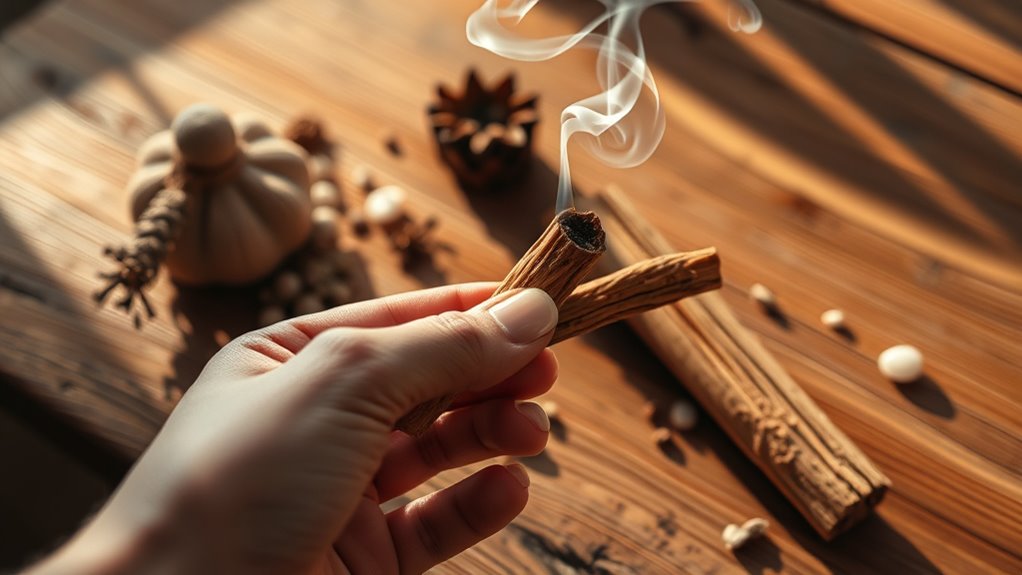When using Palo Santo, focus on sourcing it sustainably by choosing suppliers that practice responsible harvesting and support indigenous communities. Respect its cultural roots and avoid products that harm forests or deplete resources. Supporting fair trade guarantees you honor traditional uses and help preserve ecosystems. Being mindful of these ethics not only benefits the environment but also respects cultural traditions. If you’re interested, you’ll discover how your choices can make a positive impact.
Key Takeaways
- Choose sustainably sourced Palo Santo from suppliers practicing responsible harvesting, such as collecting fallen or dead wood.
- Respect the cultural significance by understanding its traditional uses and avoiding commercial exploitation.
- Support fair trade vendors that provide transparency about their sourcing practices and benefit indigenous communities.
- Use Palo Santo mindfully to prevent overharvesting, which can threaten tree populations and ecosystems.
- Educate yourself and others on the environmental and cultural impacts to promote ethical and respectful use.

Have you ever wondered about the ethical considerations behind using Palo Santo? If so, you’re not alone. Many people are becoming more conscious of how their choices impact the environment and the cultures they draw from. When it comes to Palo Santo, one of the most important aspects to consider is sustainable sourcing. This aromatic wood, native to regions like South America, grows slowly and is often harvested in ways that can harm the environment if not done responsibly. Unsustainable harvesting can lead to deforestation, loss of biodiversity, and even endangerment of the species. To ensure you’re practicing ethically, look for sources that prioritize sustainable harvesting methods, such as collecting fallen branches or dead wood, rather than cutting down live trees. Supporting suppliers who adhere to these practices helps preserve the Palo Santo trees and maintains the ecological balance of the regions where they’re grown.
Equally important is cultural respect. Palo Santo has deep roots in Indigenous and Latin American spiritual traditions, where it’s used in rituals and ceremonies to purify spaces and invite positive energy. When you incorporate Palo Santo into your practice, it’s essential to honor its cultural significance. Avoid treating it as a mere fragrance or trendy accessory, and instead, educate yourself about its traditional uses and the communities that have cultivated this practice for generations. Recognizing and respecting the cultural origins of Palo Santo helps prevent cultural appropriation and ensures that the communities who have relied on this wood receive acknowledgment and fair compensation. Many Indigenous groups have faced exploitation, with their resources taken without regard for their traditions or well-being. By choosing ethically sourced Palo Santo and supporting fair trade practices, you contribute to a more respectful and equitable exchange.
In addition, becoming aware of the source of your Palo Santo can deepen your connection to its spiritual and cultural significance. Seek out vendors who provide transparency about their sourcing practices and who give back to the communities involved. This not only ensures that you’re respecting cultural traditions but also encourages a sustainable supply chain that benefits everyone. Being informed about the environmental impact of harvesting practices can guide you in making responsible choices that support conservation efforts. Remember, your choices as a consumer can influence the industry and promote ethical standards. By prioritizing sustainable sourcing and cultural respect, you’re not just using Palo Santo—you’re participating in a conscious practice that honors the environment, indigenous traditions, and the integrity of your spiritual journey.
Frequently Asked Questions
Is It Safe to Burn Palo Santo Indoors?
Yes, burning Palo Santo indoors can be safe if you guarantee proper ventilation and use sustainable harvesting practices. Always burn it in well-ventilated areas to avoid smoke buildup. Remember, Palo Santo holds deep cultural significance, so respect its origins and avoid overharvesting. By choosing ethically sourced sticks, you support sustainable harvesting and honor the tradition behind this sacred wood, making your practice both safe and respectful.
Can I Grow Palo Santo at Home?
You can grow palo santo at home if you follow sustainable sourcing and proper cultivation practices. Start by obtaining ethically sourced seeds or saplings from reputable suppliers committed to conservation. Make sure you provide well-draining soil, plenty of sunlight, and avoid over-harvesting from wild populations. With patience, consistent care, and respect for the environment, you can cultivate palo santo responsibly and enjoy its benefits without harming natural ecosystems.
How Do I Identify Authentic Palo Santo?
You’ll find that authentic palo santo has a smooth, light wood scent with subtle citrus notes. Look for sustainably harvested pieces, avoiding those that seem overly uniform or freshly cut. Authentic sourcing guarantees the wood isn’t from endangered trees, helping preserve the species. Only buy from reputable suppliers who provide clear information about their harvest methods. Remember, genuine palo santo often has a natural, weathered look, not a glossy or slick finish.
Are There Any Health Risks From Palo Santo Smoke?
You should be aware that burning palo santo can pose health concerns, especially regarding respiratory risks. The smoke contains particulates and potentially irritating compounds, which might cause coughing or breathing discomfort if you’re sensitive or have asthma. To minimize risks, make certain of proper ventilation and limit exposure. If you experience any respiratory issues, it’s best to avoid inhaling the smoke altogether and consult with a healthcare professional.
What Are Eco-Friendly Alternatives to Palo Santo?
You can explore eco-friendly alternatives like sage bundles, cedar, or sweetgrass, which support sustainable harvesting and eco-conscious practices. These options are widely available and often harvested in ways that respect the environment. By choosing these alternatives, you help reduce demand for Palo Santo and promote the preservation of natural resources. Always seek sources committed to sustainability to guarantee your spiritual practices align with environmental responsibility.
Conclusion
As you light the Palo Santo, imagine the warm glow filling the air, carrying your intentions with its gentle smoke. Respect its origin and the communities behind it, knowing your mindful practice helps preserve its sacredness. When you honor the earth and its gifts, each ember becomes a symbol of harmony—reminding you that true connection comes from practicing with care, reverence, and gratitude. Let each use be a mindful dance with nature’s sacred spirit.









